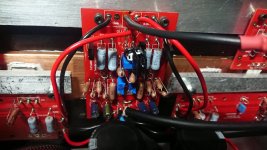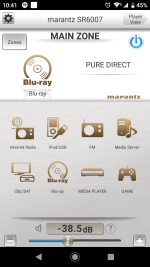Hello everyone
I built an F5Turbo running at 39V rails(with load) some time back and recently started listening test. I also have Aleph2 with 56V rails.
Setup :
Setup1 : SR6007 AV Receiver Preout > F5 Tv3 and Aleph2 > SB12.3 Speaker
Setup2 : SR6007 AV Receiver > Monitor Audio BX6
Currently I am using one pair of JFET and cascode transistor and no diodes in O/P boards.
The SR6007 preamp section gain is 15.6dB, power amp section is 27.8dB
F5T Gain 22dB
Aleph2 < 22dB
Speaker Sensitivity : 92dB(I can't improve further at this point)
Attached images with appropriate names.
Observation:
With Setup1 I do not hear anything when the volume slider is midway, only when I slide past centre I begin to hear music. The sound is clean.
With Setup2 I hear music when volume slider is midway. I believe it has to do with gain of each amplifier.
F5T is bit louder than Aleph2.
What I am trying to achieve :
I want to increase the loudness at lower volumes levels without compromising sound quality. more gain(more than 27dB).
Questions I have only for F5T:
1. If I use 2 pair of JFET, can I increase the rail voltage between 50-56 VDC without any other changes to circuit(Caps are rated 75VDC)?
2. Currently with rail voltage 39VDC, the P-Channel bias 0.356V and N-Channel bias 0.327V, does increasing bias beyond this has any advantage? if yes what value should I bias them to for 53VDC rails(what is the upper limit without compromising sound quality).
3. Will above two steps help in what I am trying to achieve.
4. If I still need more gain, with below approach what resistor value should I use without any impact to circuit functionality or sound quality. What I mean is I do not want to make more changes since I do not understand the functioning.
Someone's post : "Using the search function showed some comments on using 380R resistors in parallel for R7 - R10 increasing the gain to 26db instead of the 22db.I was aiming for +6dB over the V2 turbo (21.6dB) could I use 500R resistors in parallel or is that too much decreasing the feedback ?"
Thank you
I built an F5Turbo running at 39V rails(with load) some time back and recently started listening test. I also have Aleph2 with 56V rails.
Setup :
Setup1 : SR6007 AV Receiver Preout > F5 Tv3 and Aleph2 > SB12.3 Speaker
Setup2 : SR6007 AV Receiver > Monitor Audio BX6
Currently I am using one pair of JFET and cascode transistor and no diodes in O/P boards.
The SR6007 preamp section gain is 15.6dB, power amp section is 27.8dB
F5T Gain 22dB
Aleph2 < 22dB
Speaker Sensitivity : 92dB(I can't improve further at this point)
Attached images with appropriate names.
Observation:
With Setup1 I do not hear anything when the volume slider is midway, only when I slide past centre I begin to hear music. The sound is clean.
With Setup2 I hear music when volume slider is midway. I believe it has to do with gain of each amplifier.
F5T is bit louder than Aleph2.
What I am trying to achieve :
I want to increase the loudness at lower volumes levels without compromising sound quality. more gain(more than 27dB).
Questions I have only for F5T:
1. If I use 2 pair of JFET, can I increase the rail voltage between 50-56 VDC without any other changes to circuit(Caps are rated 75VDC)?
2. Currently with rail voltage 39VDC, the P-Channel bias 0.356V and N-Channel bias 0.327V, does increasing bias beyond this has any advantage? if yes what value should I bias them to for 53VDC rails(what is the upper limit without compromising sound quality).
3. Will above two steps help in what I am trying to achieve.
4. If I still need more gain, with below approach what resistor value should I use without any impact to circuit functionality or sound quality. What I mean is I do not want to make more changes since I do not understand the functioning.
Someone's post : "Using the search function showed some comments on using 380R resistors in parallel for R7 - R10 increasing the gain to 26db instead of the 22db.I was aiming for +6dB over the V2 turbo (21.6dB) could I use 500R resistors in parallel or is that too much decreasing the feedback ?"
Thank you
Attachments
Last edited:
If increasing the gain is what you are after then adjusting the R7-R10 resistor values is what you should look into; changing the rail voltage or bias currents won't accomplish that.
Thank you Dennis.
So what does higher rail voltage and high bias translate to?
I mainly want loudness at lower volume levels of AV receiver pream, just like the AV receiver amp.
So what does higher rail voltage and high bias translate to?
I mainly want loudness at lower volume levels of AV receiver pream, just like the AV receiver amp.
Last edited:
Increasing rail gives higher max output voltage swing for greater max power. Higher bias current gives higher class A power into lower impedances. Additionally, increase bias tend to lower distortion. Note either of these changes increase dissipation. Heatsinking and dissipation/temp for the output mosfets are usually the limiting factors here.
Increasing rail gives higher max output voltage swing for greater max power. - So that there is no clipping.
Higher bias current gives higher class A power into lower impedances. Additionally, increase bias tend to lower distortion. - Understood
Can you please help with calculation. With 39VDC rails biased to say 0.4V , how loud can I go?
At what AC volt measured at speaker terminals, will the amp leave class A and when will amp clip. How many watts of classA.
Sorry if it's a wrong question, I do not understand dB but I can relate loudness to ac current at speaker terminal at my desired loudness.
Higher bias current gives higher class A power into lower impedances. Additionally, increase bias tend to lower distortion. - Understood
Can you please help with calculation. With 39VDC rails biased to say 0.4V , how loud can I go?
At what AC volt measured at speaker terminals, will the amp leave class A and when will amp clip. How many watts of classA.
Sorry if it's a wrong question, I do not understand dB but I can relate loudness to ac current at speaker terminal at my desired loudness.
Update
Gain was low on Aleph2, fixed it with help of this thread. I am very happy with the results. It's loud enough.
https://www.diyaudio.com/community/threads/low-output-on-aleph-2-or.46894/
Now for F5T, I'll work on to increase the gain as suggested above by members.
Thank you everyone.
Gain was low on Aleph2, fixed it with help of this thread. I am very happy with the results. It's loud enough.
https://www.diyaudio.com/community/threads/low-output-on-aleph-2-or.46894/
Now for F5T, I'll work on to increase the gain as suggested above by members.
Thank you everyone.


